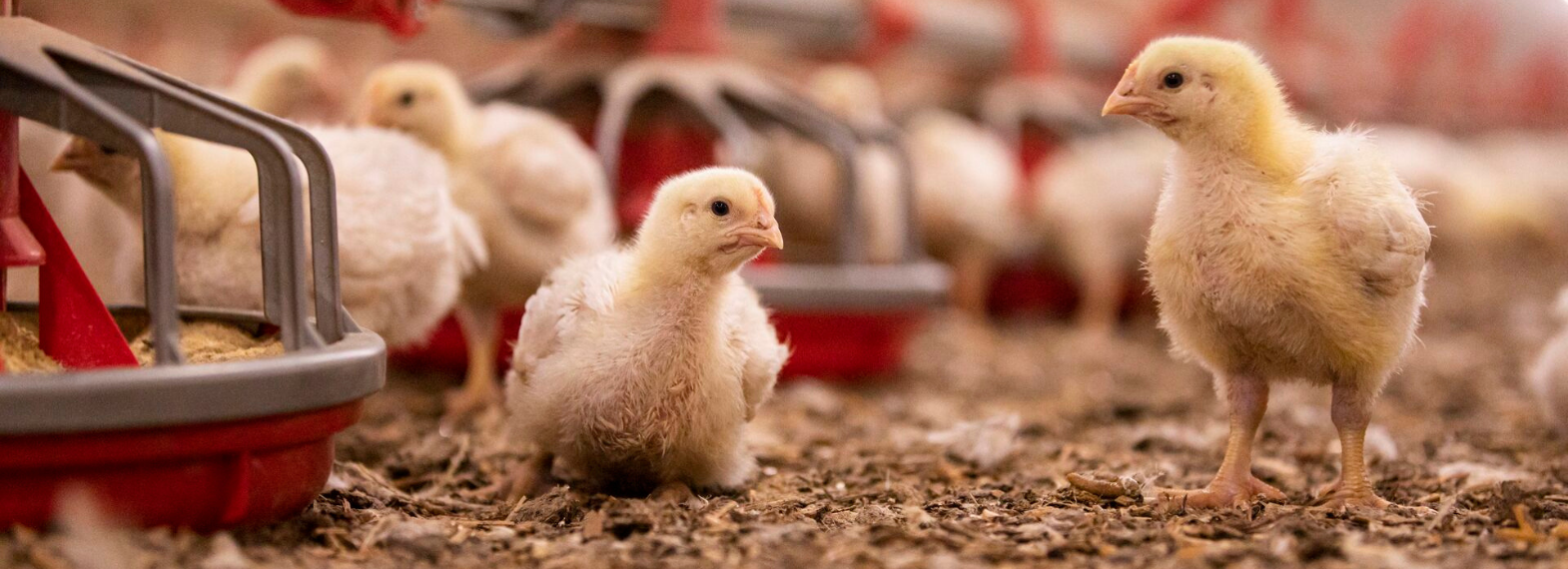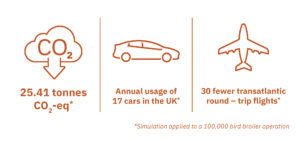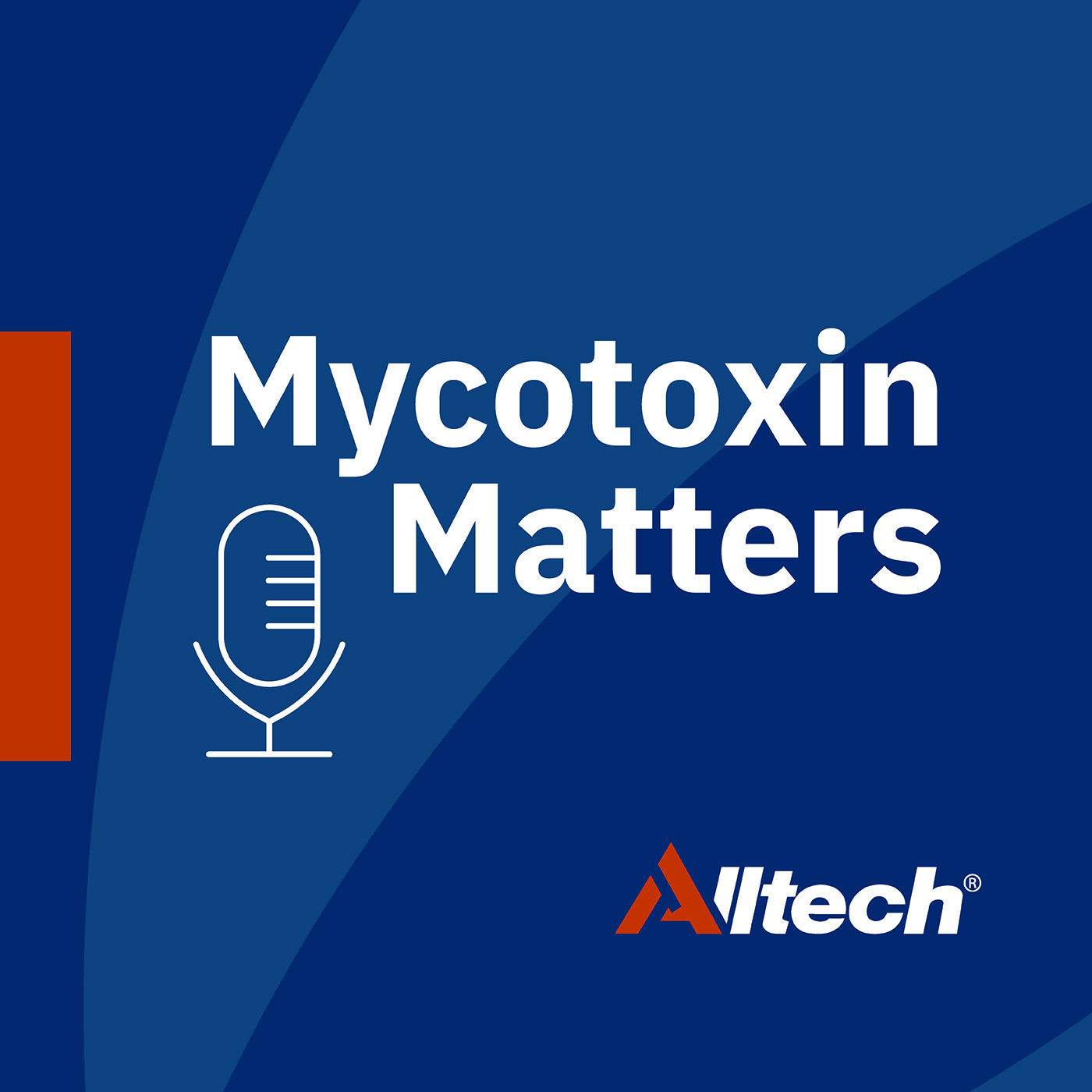Keep ahead of the threat
Stay up to date with the latest mycotoxin information by signing up to our newsletter

How nutritional solutions can enhance broiler productivity and environmental sustainability
Author: Dr. Alexandra Weaver | Global Technical Support, Alltech Mycotoxin Management
Click to listen to the Mycotoxin Matters podcast episode with Dr. Alexandra Weaver and Dr. Stephen Ross, hosted by Nick Adams. In this episode, they discuss the new meta-analysis recently published in Poultry Science, which looks at the effects of mycotoxins on broiler performance, livability, and environmental sustainability, as well as the positive effect of yeast cell wall extract supplementation during a mycotoxin challenge. You can also listen to the episode on Apple Podcasts or Spotify. You can find an edited transcript at the bottom of the page.
As the livestock industry tries to limit its environmental footprint, increasing evidence points to the role that nutritional solutions can play in meeting such targets.
Mycotoxins present an ever-increasing challenge to global agriculture. Contamination of feedstuffs by these naturally produced compounds impacts crop and feed quality, animal health, farm productivity and overall business profitability. Different management methods can be employed to counteract the mycotoxin effects on animal production. One proven method is the use of in-feed nutritional solutions such as yeast cell wall extract (YCWE) that are designed to bind or adsorb mycotoxins and remove them from the animal’s digestive tract before they have a chance to cause serious harm.
Understanding mycotoxin mitigation through a meta-analysis
Although numerous papers have been published on the use of YCWE during mycotoxin challenges, it often can be difficult to assess its overall impact as a feed additive solution for controlling mycotoxins. To enhance understanding, and compare data from multiple research papers, a meta-analysis can be performed. Suavant et al. (2008) describes a meta-analysis as a study that integrates, summarizes and quantifies results across prior research. This approach provides a robust statistical method that distils the results from a larger body of research and allows the reader to glean more effective conclusions on a topic.
Using the meta-analysis approach, Weaver et al. (2022) investigated the effects of mycotoxins in broiler production with and without the use of YCWE (YCWE, Mycosorb®, Alltech, Inc., KY) as a mycotoxin mitigation strategy. The first study of its kind in broiler production, the meta-analysis consists of 25 studies carried out across 11 countries with a total of 10,307 birds. The meta-analysis measured the impact of mycotoxins on the performance and efficiency of birds in regard to body weight gain (BWG), feed intake (FI), feed conversion ratio (FCR), European poultry efficiency factor (EPEF) and the impact of mycotoxins on bird mortality. Each of these parameters were also assessed when feeding YCWE during a mycotoxin challenge. A full copy of the recently published meta-analysis can be found in Poultry Science.
The role of mycotoxins and YCWE on broiler performance
Consumption of mycotoxin-contaminated feed by broilers can result in negative outcomes for performance and health (Awad et al, 2011; Weaver et al., 2020). Combining data from 25 individual studies, the results of this meta-analysis show that broilers consuming mycotoxins alone had significantly lower BWG (-217.2 grams), higher FCR (+0.12) and increased mortality rate (+2.07%) compared to birds fed control diets without mycotoxin contamination. These performance changes lowered the EPEF by 22.5%. Previous research by Szőllősi and Szűcs (2014) suggested that a 20% reduction of EPEF could result in a 22% decline in production output, reducing income by 1,500 EUR/flock.
Although mycotoxins negatively impacted broiler performance, the inclusion of YCWE was shown to reduce this challenge. Figure 1 demonstrates the response of birds when YCWE was included in their diets during exposure to mycotoxins. The addition of YCWE significantly increased BWG (+65.5 grams), lowered FCR (-0.05), and lowered mortality rates by 1.74% points. The EPEF was also significantly improved by 7.4%, which could result in improved farm profitability.

Figure 1. Estimated influence of feeding broilers control, mycotoxins alone or YCWE inclusion during a mycotoxin challenge on (A) feed conversion ratio (FCR) and (B) mortality rates as assessed by meta-analysis (Weaver et al., 2022).
Mycotoxins, YCWE and environmental sustainability
When it comes to the topic of mycotoxins, their impact is generally centered around economic losses either from poor feedstuff quality or reduced animal health and performance. While those factors play a significant role, it is increasingly important to also assess the contribution of mycotoxins toward environmental sustainability. This topic is gaining greater traction in the mycotoxin category and was one of the key themes at the recent World Mycotoxin Forum in Parma, Italy.
Emissions associated with feed production are often the largest contribution to greenhouse gas (GHG) output in the livestock industry, including for poultry production (MacLeod et al., 2013). Environmental impact is typically assessed using carbon footprint metrics, which refers to the total amount of GHG emissions from the production of a product along a supply chain and is expressed in kg or tonnes of CO2-equivalents (CO2-eq). As mycotoxins potentially influence the entire feed line, from crop production and quality to animal feed efficiency and animal performance and health, we now ask, how does mycotoxin presence add to the carbon footprint of livestock production?
In this meta-analysis, a simulated lifecycle assessment was conducted to investigate the role mycotoxins may play in the carbon footprint of broiler production, as well as how the use of YCWE could ameliorate the carbon footprint increase caused by mycotoxins. The study found that across 100,000 broilers, mycotoxin consumption could increase emissions by 46.62 tonnes CO2-eq, mainly resulting from poorer feed efficiency and greater mortality.
However, as this study also demonstrates, nutritional solutions such as YCWE may be a viable solution to help counteract the mycotoxin effect on carbon footprint. As seen in Figure 2, the inclusion of YCWE during the mycotoxin challenge lowered emissions by -25.41 tonnes CO2-eq per 100,000 birds compared to feeding mycotoxins alone. This reduction in carbon footprint could equate to 30 fewer round-trip transatlantic flights from London to New York.

Figure 2. How the inclusion of YCWE during a mycotoxin challenge can contribute to reducing the environmental footprint of broiler production
Although these results are generated using a simulated model, and further research is needed to fully understand the role of mycotoxins and YCWE, this study demonstrates that mycotoxins may have a bigger role than first thought on the environmental sustainability of animal production. As the agricultural industry seeks to make advances in reducing its carbon footprint, it is critical to consider the presence of mycotoxins in feedstuffs as well as the use of feed additives such as YCWE to improve animal productivity.
Supporting people, profit, and the planet
Regular testing of grains and forages highlights how mycotoxins are ubiquitous in animal feedstuffs. These contaminants negatively influence feed quality, animal health and productivity, and subsequent farm profitability. This meta-analysis reaffirms that where mycotoxins pose a problem, a mitigation solution such as YCWE contributes to an increase in total protein output, improvement of profitability and reduction of the carbon footprint of broiler production.








